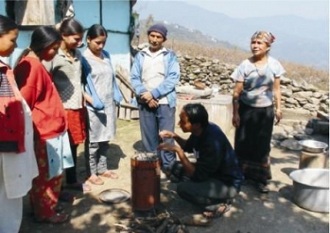Below are citations and annotation of 3 IAP studies authored or co-authored by OP Kurmi so far in 2012.
1. Eur Respir J. 2012 Jul;40(1):239-54.
Indoor air pollution and the lung in low- and medium-income countries.
Kurmi OP, Lam KB, Ayres JG.
Institute of Occupational and Environmental Medicine, School of Population and Health Sciences, University of Birmingham, Birmingham, B15 2TT, UK. E-mail: o.kurmi@bham.ac.uk.
Over half the world’s population, mostly from developing countries, use solid fuel for domestic purposes and are exposed to very high concentrations of harmful air pollutants with potential health effects such as respiratory problems, cardiovascular problems, infant mortality and ocular problems. The evidence also suggests that, although the total percentage of people using solid fuel is decreasing, the absolute number is currently increasing. Exposure to smoke from solid fuel burning increases the risk of chronic obstructive pulmonary disease (COPD) and lung cancer in adults, and acute lower respiratory tract infection/pneumonia in children. Despite the heterogeneity among studies, the association between COPD and exposure to smoke produced by burning different types of solid fuel is consistent. However, there is strong evidence that while coal burning is a risk factor for lung cancer, exposure to other biomass fuel smoke is less so. There is some evidence that reduction of smoke exposure using improved cooking stoves reduces the risk of COPD and, possibly, acute lower respiratory infection in children, so approaches to reduce biomass smoke exposure are likely to result in reductions in the global burden of respiratory disease.
2. Eur Respir J. 2012 May 31.
Lung cancer risk of solid fuel smoke exposure: a systematic review and meta-analysis.
Kurmi OP, Arya PH, Lam KB, Sorahan T, Ayres JG.
Institute of Occupational and Environmental Medicine, School of Population and Health Sciences, University of Birmingham, Birmingham, B15 2TT, UK.
The aim of this systematic review was to quantify the impact of biomass fuel and coal use on lung cancer and to explore reasons for heterogeneity in the reported effect sizes.A systematic review of primary studies reporting the relationship between solid fuel use and lung cancer was carried out, based on pre-defined criteria. Studies that dealt with confounding factors were used in the meta-analysis. Fuel types, smoking, country, cancer cell type and gender were considered in sub-group analyses. Publication bias and heterogeneity were estimated.The pooled effect estimate for coal smoke as a lung carcinogen (OR=1.82, 95% CI 1.60, 2.06) was greater than that from biomass smoke (OR=1.50, 95% CI 1.17, 1.94). The risk of lung cancer for solid fuel use was greater in females (OR=1.81, 95% CI 1.54, 2.12) compared to males (OR=1.16, 95% CI 0.79, 1.69). The pooled effect estimates were 2.33 (95% CI 1.72, 3.17) for
adenocarcinoma, 3.58 (1.58, 8.12) for squamous cell carcinoma, and 1.57 (1.38, 1.80) for tumours of unspecified cell type.These findings suggest that in-home burning of both coal and biomass is consistently associated with an increased
risk of lung cancer.
3. Eur Respir J. 2012 May 3.
Reduced lung function due to biomass smoke exposure in young adults in rural Nepal.
Kurmi OP, Devereux GS, Smith WC, Semple S, Steiner MF, Simkhada P, Lam KB, Ayres JG.
University of Birmingham, UK.
This study aimed to assess the effects of biomass smoke exposure on lung function in a Nepalese population addressing some of these methodological issues from previous studies.We carried out a cross-sectional study of adults in a population exposed to biomass smoke and a non-exposed population in Nepal. Questionnaire and lung function data were acquired along with direct measures of indoor and outdoor air quality.Ventilatory function (FEV1, FVC, FEF25-75) was significantly reduced in the population using biomass across all age groups compared to the non-biomass using population, even in the youngest (16-25) age group [mean FEV1 (95% CI) 2.65 (2.57-2.73) vs. 2.83 (2.74-2.91), p=0.004]. Airflow obstruction was twice as common among biomass users compared to liquefied petroleum gas users (8.1% vs. 3.6%, p<0.001) with similar patterns for males (7.4% vs. 3.3%, p=0.022) and females (10.8% vs. 3.8%, p<0.001) based on lower limit of normal. Smoking was a major risk factor for airflow obstruction but biomass exposure added to the risk. Exposure to biomass smoke is associated with deficits in lung function, an effect which can be detected as early as late teenage years. Biomass smoke and cigarette smoke have additive adverse effects on airflow obstruction in this setting.



